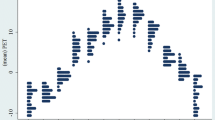Abstract
The aim of this study was to develop a method for the identification of global weather parameters and patient characteristics associated with a type of heart attack in which there is a sudden partial blockage of a coronary artery. This type of heart attack does not demonstrate an elevation of the ST segment on an electrocardiogram and is defined as a non-ST elevation acute coronary syndrome (NSTE-ACS). Data from the Global Summary of the Day database was linked with the enrollment and baseline data for a phase III international clinical trial in NSTE-ACS in four 48-h time periods covering the week prior to the clinical event that prompted enrollment in the study. Meteorological events were determined by standardizing the weather data from enrollment dates against an empirical distribution from the month prior. These meteorological events were then linked to the patients’ geographic region, demographics and comorbidities to identify potential susceptible populations. After standardization, changes in temperature and humidity demonstrated an association with the enrollment event. Additionally there appeared to be an association with gender, region and a history of stroke. This methodology may provide a useful global insight into assessing the biometeorologic component of diseases from international data.




Similar content being viewed by others
References
Amiya S, Nuruki N, Tanaka Y, Tofuku K, Fukuoka Y, Sata N, Katsuro K, Hirohito T (2009) Relationship between weather and onset of acute myocardial infarction: can days of frequent onset be predicted? J Cardiol 54(2):231–237
Barnett AG, Dobson AJ, McElduff P, Salomaa V, Kuulasmaa K, Sans S et al (2005) Cold periods and coronary events: an analysis of populations worldwide. J Epidemiol Commun Health 59(7):551–557
Bhaskaran K, Hajat S, Haines A, Herrett E, Wilkinson P, Smeeth L (2009) Effects of ambient temperature on the incidence of myocardial infarction. Heart 95(21):1760–1769
Calcagno V, de Mazancourt C (2010) Model selection and multimodel inference: an information theoretic approach. J Stat Softw 34(12):1–29
Chang CL, Shipley M, Marmot M, Poulter N (2004) Lower ambient temperature was associated with an increased risk of hospitalization for stroke and acute myocardial infarction in young women. J Clin Epidemiol 57(7):749–757
Cowperthwaite MC, Burnett MG (2011) An analysis of admissions from 155 United States hospitals to determine the influence of weather on stroke incidence. J Clin Neurosci 18(5):618–623
Danet S, Richard F, Montaye M, Beauchant S, Lemaire B, Graux C et al (1999) Unhealthy effects of atmospheric temperature and pressure on the occurrence of myocardial infarction and coronary deaths. A 10-year survey: The Lille-World Health Organization MONICA project (monitoring trends and determinants in cardiovascular disease). Circulation 100(1):E1–7
Ebi KL, Exuzides KA, Lau E, Kelsh M, Barnston A (2004) Weather changes associated with hospitalizations for cardiovascular diseases and stroke in California, 1983–1998. Int J Biometeorol 49(1):48–58
Fernandez-Raga M, Tomas C, Fraile R (2010) Human mortality seasonality in Castile-Leon, Spain, between 1980 and 1998: the influence of temperature, pressure and humidity. Int J Biometeorol 54(4):379–392
Frost DB, Auliciems A (1993) Myocardial infarct death, the population at risk, and temperature habituation. Int J Biometeorol 37(1):46–51
Gill JS, Davies P, Gill SK, Beevers DG (1988) Wind-chill and the seasonal variation of cerebrovascular disease. J Clin Epidemiol 41(3):225–230
Hirasawa K, Tateda K, Shibata J, Yokoyama K (1990) Multivariate analysis of meteorological factors and evaluation of circadian rhythm: their relation to the occurrence of acute myocardial infarction. J Cardiol 20(4):797–805
Miric D, Rumboldt M, Rumboldt Z (1993) The impact of meteorological factors on the onset of myocardial infarction in the coastal region of middle Dalmatia. G Ital Cardiol 23(7):655–660
Morabito M, Crisci A, Vallorani R, Modesti PA, Gensini GF, Orlandini S (2011) Innovative approaches helpful to enhance knowledge on weather-related stroke events over a wide geographical area and a large population. Stroke 42(3):593–600
Morabito M, Modesti PA, Cecchi L, Crisci A, Orlandini S, Maracchi G, Gensini GF (2005) Relationships between weather and myocardial infarction: a biometeorological approach. Int J Cardiol 105(3):288–293
NCDC National Climatic Data Centre (2011) National Oceanic and Atmospheric Administration Global Summary of the Day. Retrieved 15 May 2011 [http://www.ncdc.noaa.gov/cgi-bin/res40.pl?page=gsod.html]
Revich B, Shaposhnikov D (2008) Temperature-induced excess mortality in Moscow, Russia. Int J Biometeorol 52(5):367–374
Simoons ML, GUSTO IV-ACS Investigators (2001) Effect of glycoprotein IIb/IIIa receptor blocker abciximab on outcome in patients with acute coronary syndromes without early coronary revascularisation: the GUSTO IV-ACS randomised trial. Lancet 357(9272):1915–1924
Steadman RG (1979) The assessment of sultriness. Part I: a temperature-humidity index based on human physiology and clothing science. J Appl Meteorol 18:861–873
Turin TC, Rumana N, Kita Y, Nakamura Y, Miura K, Ueshima H (2010) Ambient weather conditions and the onset of acute myocardial infarction: the consociation between triggering factors and conventional risk factors. J Cardiol 55(2):283–284
Wolf K, Schneider A, Breitner S, von Klot S, Meisinger C, Cyrys J (2009) Air temperature and the occurrence of myocardial infarction in Augsburg, Germany. Circulation 120(9):735–742
Acknowledgments
We would like to thank Dr. Elliot Barnathan (Johnson&Johnson Inc.) for his assistance in defining site locations in the GUSTO IV ACS trial. The GUSTO-IV ACS trial was sponsored by Centocor (Malvern, PA); no directed funding was received for the current study.
Author information
Authors and Affiliations
Corresponding author
Rights and permissions
About this article
Cite this article
Bakal, J.A., Ezekowitz, J.A., Westerhout, C.M. et al. Association of global weather changes with acute coronary syndromes: gaining insights from clinical trials data. Int J Biometeorol 57, 401–408 (2013). https://doi.org/10.1007/s00484-012-0565-3
Received:
Revised:
Accepted:
Published:
Issue Date:
DOI: https://doi.org/10.1007/s00484-012-0565-3




